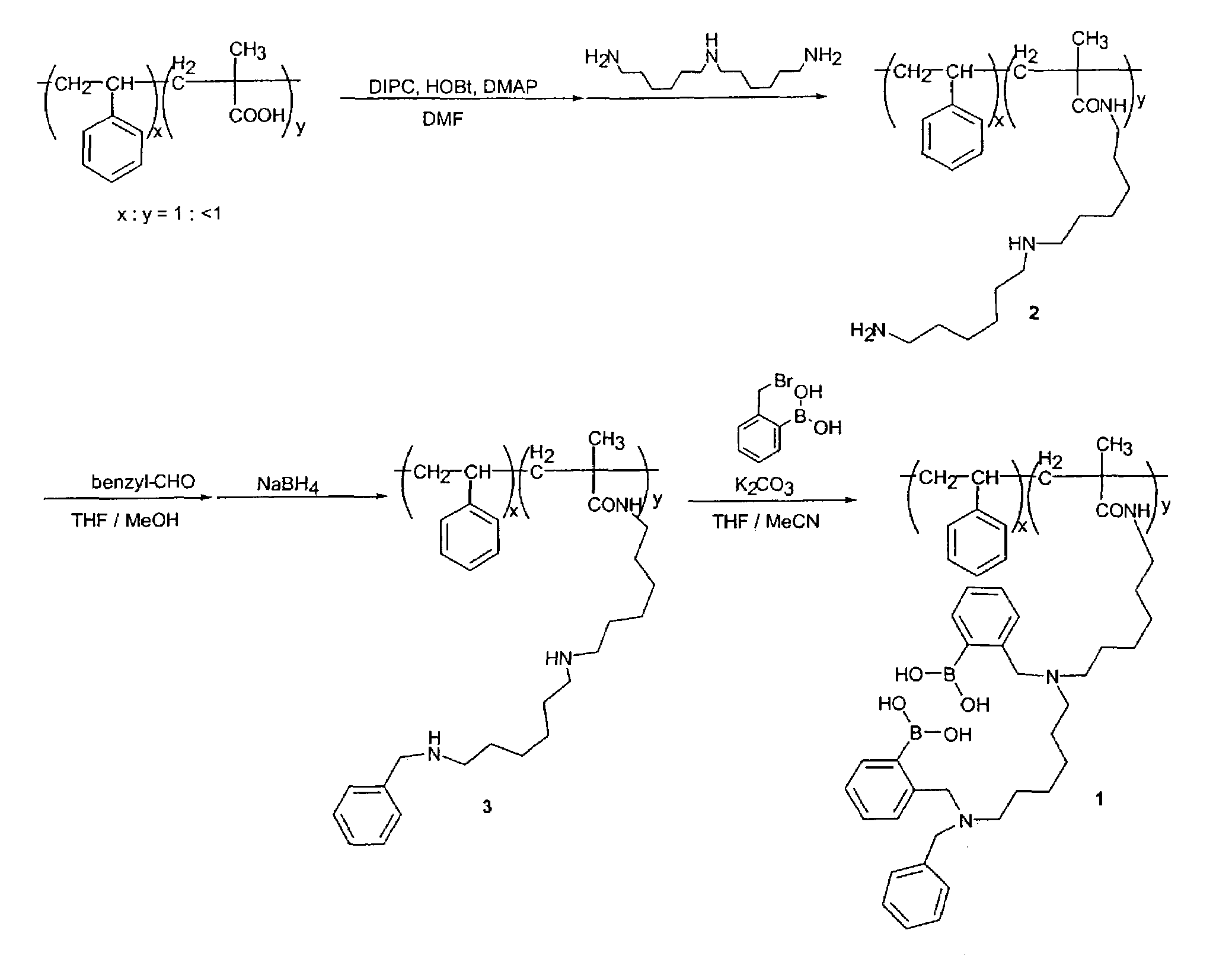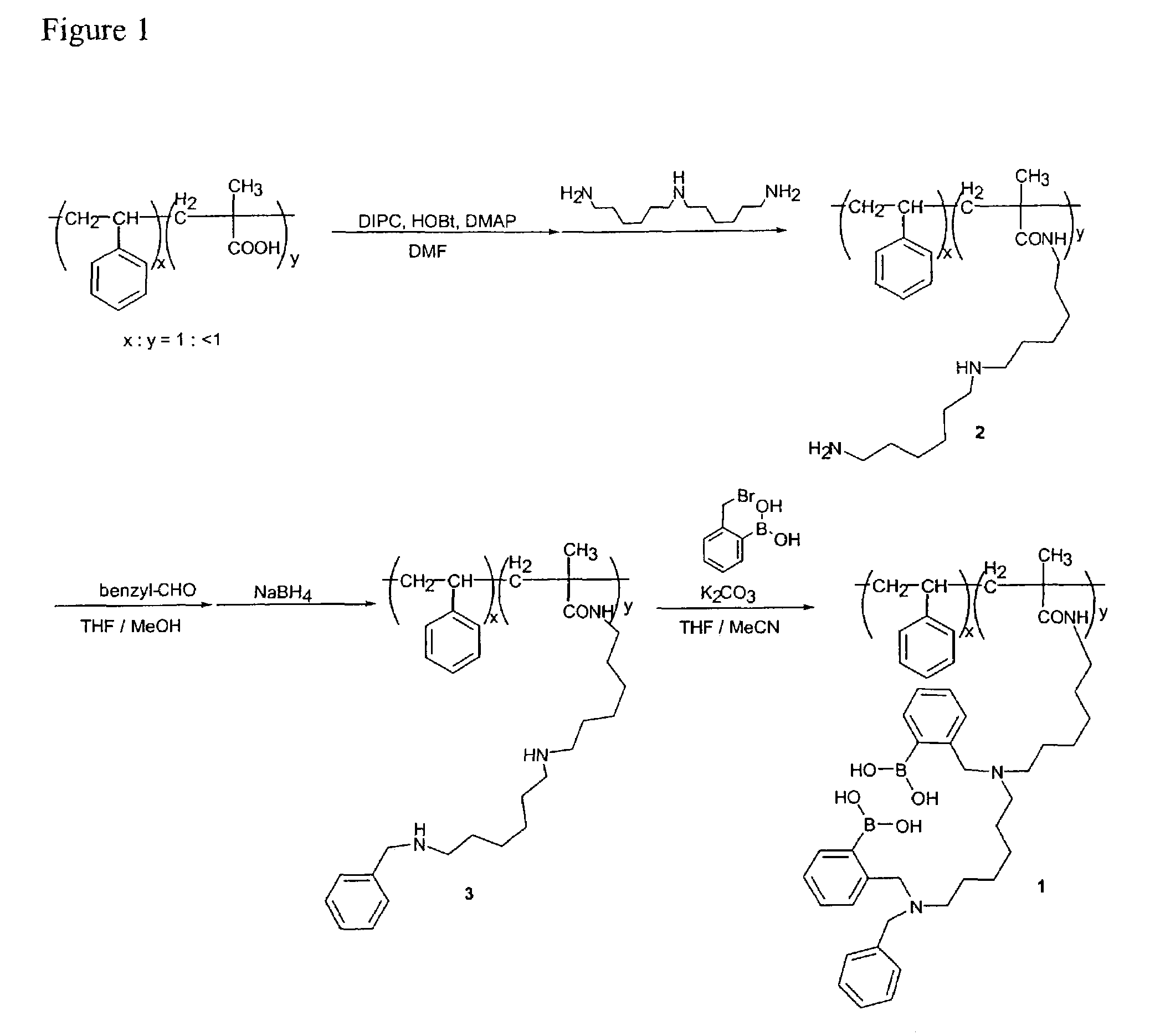Sensor system for saccharides
a technology of saccharide and sensor system, which is applied in the field of fluorescence sensor molecules, can solve the problems of imposing strict limitations on the type of fluorophore, its size and conformation, and serious shortcomings, and achieves significant limitations on the type, size and conformation of analytes that can specifically bind to the disclosed fluorescent compounds
- Summary
- Abstract
- Description
- Claims
- Application Information
AI Technical Summary
Benefits of technology
Problems solved by technology
Method used
Image
Examples
example i
[0114]The fluorescent sensor of the formula (5) was prepared as described in detail below.
Preparation of N-benzyl-hexane-1,6-diamine
[0115]A solution of hexamethlene-1,6-diamine (17.15 g, 148 mmol) and benzaldehyde (3.0 ml, 29.5 mmol) in tetrahydrofuran (THF) (300 ml) and ethanol (75 ml) was stirred at room temperature for 24 hours under a nitrogen atmosphere. The solvent was removed and the oil was dried under vacuum. The dried residue was dissolved in THF (100 ml) and sodium borohydride (5.58 g, 148 mmol) was added to the solution. The solution was stirred at room temperature for 7 hours under nitrogen atmosphere. Methanol and water were added to the solution and the solvents were removed under vacuum. The obtained oil was dissolved in chloroform, and washed with water. The solution was dried over magnesium sulphate and the solvent was then removed under vacuum to give a colorless oil (4.49 g, 74%). 1H NMR (CDCl3) δ / ppm 1.1-1.5 (8H, m, (CH2)4), 2.55 (2H, t, NHCH2), 2.65 (2H, t, ArC...
example ii
[0119]A relative fluorescent intensity of the sensor of formula (5), as prepared in EXAMPLE I, was measured in 52.1 wt % methanol and phosphate buffer (pH 8.21) with various D-glucose concentrations (FIG. 3). Phosphate buffer was prepared as described in D. D. Perrin, and B. Dempsey, Buffers for pH and Metal Ion Control, Chapman and Hall, London, 1974. The fluorescence spectra were recorded as increasing amounts of D-glucose were added to the solution. The mixture solutions were measured excitation at 342 nm. The fluorescent intensity was found to correlate with total D-glucose concentration in the solution.
example iii
Preparation of Beads with Glucose Binding Sensor (Prospective Example)
[0120]The preparation of a glucose binding sensor to beads is illustrated in detail in FIG. 1. The beads are 5.6 micrometer diameter poly (styrene / 5.5% divinyl benzene / 5% methacrylic acid), available from Bangs, Laboratories, Inc. of Fishers, Ind. Compound 2 illustrated in FIG. 1 is prepared by stirring a suspension of cross-linked carboxylate modified polymer beads (200 mg), 1,3-diisopropylcarbodiimide (DIPC) (170 mg), 1-hydroxy-1H-benzotriazol (HOBt) (200 mg,), 4-N,N-dimethylaminopyridine (DMAP) (8 mg) in N,N-dimethylformamide (DMF) (5 ml) on an ice bath under nitrogen atmosphere for 30 minutes. Next, bis(hexamethylene) triamine (1.0 g) is added to the solution and stirred at room temperature for 1 day. This reaction mixture is poured into tetrahydrofuran (THF) and stirred for 1 h at room temperature. The mixture is centrifuged to settle the beads, the supernatant was decanted, and the beads are resuspend in met...
PUM
| Property | Measurement | Unit |
|---|---|---|
| Nanoscale particle size | aaaaa | aaaaa |
| Nanoscale particle size | aaaaa | aaaaa |
| Ratio | aaaaa | aaaaa |
Abstract
Description
Claims
Application Information
 Login to View More
Login to View More - R&D
- Intellectual Property
- Life Sciences
- Materials
- Tech Scout
- Unparalleled Data Quality
- Higher Quality Content
- 60% Fewer Hallucinations
Browse by: Latest US Patents, China's latest patents, Technical Efficacy Thesaurus, Application Domain, Technology Topic, Popular Technical Reports.
© 2025 PatSnap. All rights reserved.Legal|Privacy policy|Modern Slavery Act Transparency Statement|Sitemap|About US| Contact US: help@patsnap.com



